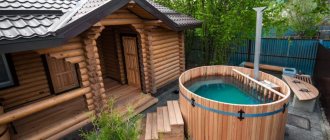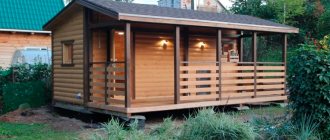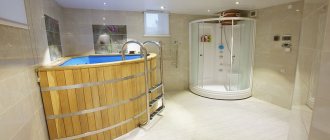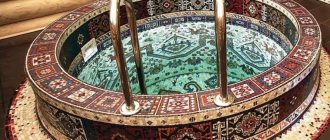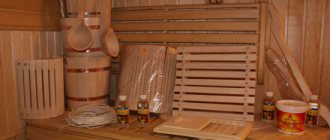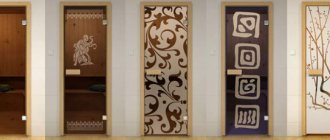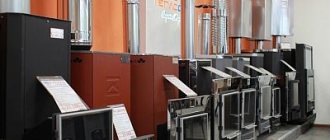The severe cold has finally arrived in our city. The sweetest thing: flood the bathhouse and splash around in the warm water when it’s minus 15 degrees outside. The feeling is unforgettable.
If you are wondering whether you need a heated font on your property, then I am writing this article just for you. I’ll tell you about my experience of using a wooden cedar font at the dacha and share recommendations for choosing the best model.
Font made of plastic or wood: pros and cons
Of course, in terms of operation, a composite hot tub wins: it is reliable, durable, does not rot, does not leak, and is significantly cheaper - prices start at 25,000 rubles. Of the minuses: the appearance suffers, there is no that unique feeling of a living tree. Plastic is plastic.
The advantages of hot tubs made of cedar, larch or oak wood are obvious: beauty, aesthetics, environmental friendliness. Some people write about some mysterious phytoncides, but I’m not sure about this. An important advantage of a living tree is its pleasant resinous aroma. But there are also significant disadvantages: they are more demanding to care for, dry out without water, and can leak. Well, the prices, you know, are not small - you can buy one from us for 100,000 rubles.
For myself, of course, I definitely made a choice in favor of a wooden model. I work with wood, I love the smell and texture of wooden products and would never trade it for plastic. But if you evaluate it rationally, then it makes sense to combine it: make a plastic container an insert into a wooden lining. Wooden benches and a ladder should also be installed. Prices for good models start from 70,000 rubles.
Types of tank by type of installation
Taking into account personal preferences and budget, you can install several types of hot tubs:
- In-depth. As a rule, such tanks are small in size and volume. For ease of use, they are additionally equipped with a small non-slip ladder.
Such containers should be designed immediately with the main building of the bathhouse in order to make a reliable frame and fill. In-depth models are considered the most comfortable, functional and durable. The best option for placing them inside the bathhouse is the dressing room. - Pouring. The simplest type of font, but due to the peculiarities of the procedure, which involves a sharp dousing of the body, is not suitable for everyone. A special ladle, barrel or any other container is simply mounted on the wall and turned over at the right time using a lever.
In terms of maintenance, such bathtubs are the simplest and do not require special care. They are usually installed only where it is not possible to equip a full-fledged swimming pool or open tank. - Open. Typically, such tanks are installed next to or inside the bathhouse, connecting to a common water supply and sewerage network. At their core, these are simply large barrels made of wood, metal, stone or plastic of various shapes and volumes, which can also be equipped with a ladder.
Expert opinion
Lovkachev Boris Petrovich
Bath master who knows everything about steaming
Attention! Recessed hot tubs can also be installed outdoors. But in such tanks it is better to provide a heating system if you plan to use it in the cold season.
Which stove to choose for a hot tub - external or submersible?
I used fonts with both an external (“Ofuro”) and an internal stove (“Pechnov”). Of course, an external oven is better and more convenient. More space is saved, it’s more convenient to store firewood, and you don’t need to come up with a protective box in the container itself.
This is my hot tub with an external stove:
And for comparison, the oven located inside:
The heating time is the same: our standard cone-shaped font with a volume of about 2300 liters heats up in about 3 hours at an ambient temperature of -15 degrees. In summer, heating is reduced to 1.5 hours.
Views based on shape
If you wish, you can make a tank of any shape you like. But in the classic version, it is recommended to install time-tested configurations.
Oval
Today it is considered the most popular form, as it fits easily in small baths, allowing several people to use the font at the same time. They do not require special skills during installation.
Round
Taking into account the volume, they can be installed in small baths and huge complexes. Their structure resembles Japanese bathing barrels. Most often, these structures are equipped with heating and hydromassage.
Rectangular or square
Such forms are most often used for arranging in-depth structures. The main advantage of such bowls is ease of installation.
Triangular
They are used only in small rooms, as they are installed in a corner to save space. If necessary, they can also be equipped with heating. Almost never installed in recesses.
An interesting option is the font, which has two reservoirs. One contains cold water, the other contains warm water. As a rule, such models have their own heating system or are connected to a sauna stove. In the latter case, it is necessary to provide a thermostat to regulate the water temperature
Which bath font should you choose: cedar, larch or oak?
Here, look at the situation. Each wood has its own advantages:
- Larch is less susceptible to rotting and drying out (I heard stories that St. Petersburg and Venice still partially stand on pillars made of larch);
- Cedar is the most fragrant of these trees. In addition, it has a very beautiful pinkish tint. But knotty. Oil release is also often mentioned as a benefit, but I don’t believe in that at all. After 2-3 years of constant use, it’s unlikely that anything else stands out.
- Oak has the highest density, which means an oak font is less susceptible to drying out and swelling. This is, of course, very good. But the price matches.
Questions and answers
Which font is better from the point of view of human health?
If you want to achieve maximum benefit from the procedure, it is better to install wooden or concrete tanks if possible.
How often should recessed hot tubs be cleaned?
As a rule, the water in them is not drained for a long time, which leads to the formation of plaque. If no antiseptic is added to the tank, then the tank should be flushed at least once every two weeks.
Where is the best place to start installing a hot tub?
Before choosing a material, it is recommended to initially decide on the installation location and how the water supply and sewerage system will be connected.
Which hot tub is easiest to equip?
The simplest fonts are assembled from plastic bowls, but they are also the most harmful if we evaluate them from the point of view of environmental friendliness.
5. What volume of the font is best to choose?
It all depends on the area of the room and your budget. There are small models with a volume of 1 cubic meter. m., and there are huge tanks with a volume of over 25 cubic meters. m.
A hot tub in a bathhouse is an excellent solution for healing the entire body and conducting contrast procedures. Suitable material and correct installation guarantee not only pleasure from the procedure, but also its maximum benefit.
What kind of foundation is needed for a font?
Of course, a foundation is needed and preferably a pile-screw foundation so that the font does not move or move. Then leaks will appear less often. It is also permissible to install the font on a strong, level base - for example, on a concrete slab or asphalt platform. But putting the font on foundation blocks or directly on the ground - well, no, that’s not serious.
When we make baths with a built-in plunge pool on the terrace, we must additionally install 4 screw piles. Look how beautiful it is:
And here’s what a timber bathhouse with a font looks like from the side:
How to make a font with your own hands?
If you wish, you can build a font yourself. It can be made of wood, poured with concrete, another option is to buy a ready-made plastic bowl and install it.
How to make a wooden font?
- Assemble the bottom. To do this, you need to lay tongue and groove boards in a row on the work surface, coat them with glue and connect them into a rectangle, secure with clamps and leave until completely dry. Cut out the desired shape using a jigsaw. Make legs for the font: screw two bars on the bottom side with screws.
- Make a drain. Insert the tube, attach the siphon to the boards with self-tapping screws and connect it to the pipe. Treat the contact area between the bottom and the siphon with sealant to prevent the font from leaking.
- Assemble the walls. Using a cutter, make a groove on each board on one side and a protrusion of suitable size on the other. You also need to make a rectangular groove on the back of each board so that you can then insert the rail into the bottom of the font.
- Assemble the font. Connect the slats into a single structure by inserting the protrusions into the grooves. Strengthen the walls with metal clamps. Usually it is enough to make three inserts at equal distances from each other. They need to be nailed with small nails and tightened with bolts.
- Sand it with sandpaper. It is necessary to sand the outer and inner sides of the structure so that splinters do not appear during its operation.
- Install the font. Place the wooden bath barrel in a pre-selected location, connect the siphon to the sewer pipe and lead it to the drain hole.
- Install additional elements. If the font comes with benches, ladders, or shelves, then you need to attach them using self-tapping screws, and their heads should go slightly deeper into the board.
We recommend reading:
Fiber optic bath lighting
How to make a concrete font?
The peculiarity of installing a concrete font is that if you plan to place it in a bathhouse, then you need to design it at the stage of building the bathhouse itself. This is due to the fact that such a font requires preparation of a pit.
- Prepare the pit. Dig a hole about 1.5 m deep. The width and length can be different, they depend on the desired size of the font. But you need to take into account that the width of the concrete walls will be approximately 15 cm.
- Prepare the drain. Usually, for concrete baths, water is pumped out using a pump, in which case you can skip this point. If you plan to install a drain, then you need to make a trench in the wall of the pit at a slope towards the drainage pit and lay a plastic pipe.
- Fill the bottom of the pit with sand, the layer thickness should be about 10 cm.
- Install fittings. Cut it and place it on the bottom in the form of a lattice at a height of 5 cm above the bottom. Connect the rods using wire. To lift the reinforcement, use special plastic clamps, hammer 4 pins, pieces of bricks or pipe cuttings into the base.
- Install formwork using plywood sheets or boards. They should be 5 cm above the reinforcing grid. Strengthen the formwork with timber to prevent deformation of the walls under the weight of concrete.
- Prepare the solution and pour it in stages. It is also recommended to strengthen the solution using a crowbar or metal rod. Smooth out the walls with a trowel and leave the concrete to dry. To protect the surface from cracks, you need to cover the sides with a thick film and moisten them. Strengthening the walls will take approximately 4 weeks.
- Carefully remove the formwork and level the floor with a screed about 7 cm thick.
- When the bottom is dry, plaster the walls. The layer thickness should be 0.3-10 mm.
- Treat the surface of the font with a special waterproofing mixture. On average you will need 3-4 layers.
- To decorate the sides, you can use ceramic tiles or rubber paint.
- Install the necessary elements: stairs, lighting, jacuzzi, etc.
How to install a plastic font?
This method is the simplest, since in this case a ready-made container is used; you do not need to make it yourself.
- Make a hole in the font for drainage. Place it in the chosen place. When installing a drain pipe, you need to thoroughly waterproof the place where it connects to the font.
- Install a frame made of beams with a cross-section of 50×50 mm around the font, and secure wooden slats to it. The beams must first be treated with a water-repellent compound. The frame should follow the shape of the plastic container. Connect the beams using self-tapping screws, plates and metal corners.
- Cover the frame with boards 3 cm thick. They will serve only a decorative function; lining and plastic panels are suitable for this purpose.
The sauna font will make your visit to the sauna even more enjoyable and comfortable.
Comparative characteristics
Wooden containers have the advantage of natural wood. These are baths that have a unique aroma and effect. However, these undoubtedly positive qualities are neutralized when using the cold font. Cold wood does not sufficiently saturate the air with its aroma; you will not be there for a long time and will not have time to enjoy the naturalness of your bowl.
Here, the disadvantages of wooden containers come to the fore: susceptibility to putrefactive processes, drying out during periods of inactivity, mini-leaks, and the need for constant careful maintenance.
Metal vats vary in size, weight, and shape. Stainless steel containers are lighter and easier to clean, but have thinner walls and retain heat less well than thick-walled cast iron ones. The distinctive properties of cast iron bowls are their heavy weight and fragility to impact. They are distinguished from wooden ones by a longer service life. However, in aesthetics they are inferior to both wooden and plastic models.
Concrete fonts are homemade containers that are more like a mini-pool in size. They are installed permanently on the street or in a separate room of the bathhouse. Concrete containers are an expensive option because they require additional waterproofing and aesthetic design. Here, a combined option is more common, when concrete formwork is arranged for a polymer font-liner.
Plastic and composite hot tubs do not have the disadvantages of wooden containers. They are not subject to rotting, have a significant service life, are easy to maintain and can be installed both indoors and outdoors. Plastic ones are made from organic polymers, while composite ones have fiberglass additives in the polymer, which makes them especially durable. The variability of sizes, shapes and colors is limited only by your capabilities and imagination. Any font will be made to order.
Bucket for dousing
A dousing font, also called a dousing device, can bring a lot of pleasure. To do this, attach a wooden tub to the wall of the bathhouse, movably mounted on the wall above head level. They pour cold water into it and tip it over themselves by pulling the rope. Such a cold stream falling on the head perfectly trains the cardiovascular system and strengthens the nerves. This is the cheapest, easiest and fastest way to organize hardening procedures after visiting the bathhouse.
Pouring bath font
This is the same tub of cold water that does not spoil the mood, but brings true pleasure! Take care of your health!
Classification of species
The variety of types of bath tubs is classified according to different criteria:
By shape
The shape of the font may vary depending on the material of manufacture and purpose:
- oval, assembled from wooden staves or cast from plastic;
- round, made of plastic, wood, dousing bathtubs also have a round shape;
- rectangular, cast from concrete;
- complex shapes, fit into existing structures
For self-production, wooden oval fonts and rectangular concrete ones are most often chosen.
According to the material of manufacture
Traditionally, fonts were made from wooden staves. As methods for processing other materials developed, they also began to be used to make useful bath equipment:
- metal, the container is light and durable, but slippery;
- plastic, factory cast, can be of any shape;
- concrete and tiles, a permanent structure, labor-intensive to manufacture and difficult to operate.
Bath font made of plastic
Wooden fonts are tried to be made from noble wood.
Cedar boards saturate the water with essential oils and other beneficial substances that have a beneficial effect on the human skin and nervous system. In such water you want to stay longer.
Larch practically does not rot, and fungus and mold do not grow on it. It also has a beneficial effect on the immune system; systematic bathing helps prevent colds. Bathing in larch water helps dilate blood vessels and reduce blood pressure.
Oak boards release tannins, astringent substances that have anti-inflammatory, antiseptic and restorative effects. It’s not for nothing that I age the best wines, cognacs, whiskeys and other noble drinks in oak barrels. Oak infused water promotes the healing of minor wounds and abrasions.
Boards for fonts are also made from pine, birch and beech; the effect is also positive, although not so pronounced.
To size
Small half-barrels, designed for one seated person, can fit even in cramped apartment saunas.
In a village bathhouse, double oval fonts are often installed. A font for a larger number of swimmers will already be considered a swimming pool.
Pouring fonts are small in size - a bucket of 12-20 liters.
Type and depth of the plunge pool and mini-pool
Type. It is recommended to choose a skimmer type of font/mini-pool, the depth of which is set based on the calculation: the water level you need plus 20 cm. Such bowls are easier and faster to build, equipped along the contour with a special side to prevent water from splashing out when jumping.
An overflow mini-pool is made with a length of about 15 m and a water volume of more than 100-150 cubic meters. You can also make a font overflow if the presentability of the relaxation area is your top priority.
Depth. Choose the same minimum and maximum depth of the bowl so that the bottom does not turn out to be too inclined or, conversely, with a barely noticeable difference.
For the font. The water level is determined by you in a standing position; it should be in the chest area (140-180 cm). And another 20 cm are added.
For a mini-pool. The depth can be increased a little without going too far, because... a depth of 2-3 m is the size of large swimming pools with jumping areas. The greater the depth of the mini-bowl, the greater the increase in water volume and the need for more powerful filtration equipment. The simplest such installation will easily serve a pool with a volume of 20-25 cubic meters.
Arrangement of a concrete font
Organizing a concrete swimming pool is quite difficult; it requires more time and labor, since the main thing that needs to be done is to equip a foundation pit for it.
All work is carried out according to the following scheme:
- Preparing a pit up to 1.7 m deep (the process is similar to preparing the foundation). A sand cushion up to 18 cm high is poured into the bottom. Pipes for sewerage and water supply are laid.
- Installation of a reinforced frame. The bottom is reinforced with reinforcing bars up to 15 mm thick at a height of about 6 cm from the ground level with plastic elements for fixation. A font bowl is laid out from the rods, the elements are fixed together with knitting wire or welding.
- Construction of formwork from OSB or chipboard boards, reinforced with wooden beams to a height of 6 cm from the reinforced bowl. Similar actions are performed for the outer part of the walls, while the formwork is installed only on the bottom.
- Creation of a monolithic base. Pouring the walls and bottom of the font with concrete mixture in one cycle.
- Dismantling the formwork after the concrete has completely dried. Leveling wall structures and bottom, laying a waterproofing layer.
- Decorative finishing of the structure with the selected material. For these purposes, wood, natural or artificial stone, mosaic and tiles are used.
- A concrete font is equipped with a ladder and everything that is necessary to carry out certain functions.
What is a font
A font is a special tank made of stainless steel, wood, concrete and plastic, filled with cool water for dipping after basic bath procedures. Initially, fonts were intended for washing the body and carrying out hygienic procedures.
In modern baths, various design options are used, which differ in shape, size and material of manufacture. Universal bath tubs are made of wooden planks connected by a metal hoop. More functional models of devices are equipped with a heating system or hydromassage.
The arrangement of a bathhouse provides for more efficient implementation of health procedures. After the steam room, the bathhouse attendants perform douches or immersions in cold water. Such hardening of the body helps improve blood circulation and work of the heart muscle, cleanses the skin, improves resistance to colds and improves mood.
Finishing
Mosaic (1x1 cm, 2x2 cm, 5x5 cm). Will make the bowl beautiful and aesthetically pleasing. A variety of colors - from blue and light blue to green and yellow. It will cost you little due to the small finishing area, and there will be many variations in decoration. Finishing the hot tub/mini-pool will be faster. All roundings will be neat.
Film. Suitable if you want to save money. The color of the bowl will only be blue or light blue. The installation will be simple, with a minimum number of seams. However, the film quality is lower.
Tile. This is the aesthetics of large Olympic venues; installation is technically complex.
Stone. The choice of extravagant hosts is not for everybody.
Dye. Option for an open large reservoir.
Concrete fonts
Monolithic concrete structures can have various configurations and sizes. The high strength characteristics of the hot tubs are ensured by reinforcement of the bottom and walls. This is the strongest and most durable option for structures that are installed at the stage of constructing a private steam room. The advantages of concrete products include:
- wide choice of shapes and placement locations;
- long service life;
- wear resistance and strength;
- possibility of reconstruction of the bowl.
- a variety of materials for decorative finishing.

